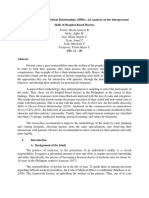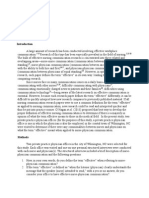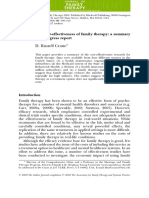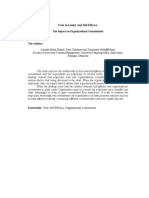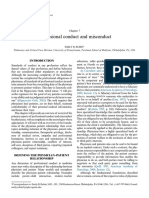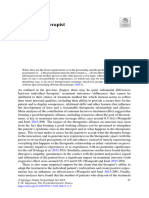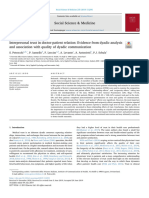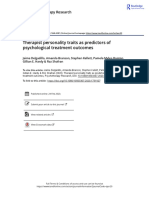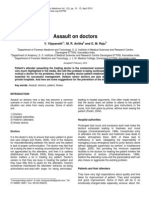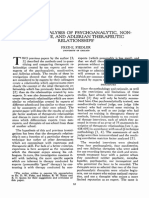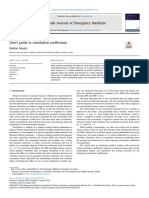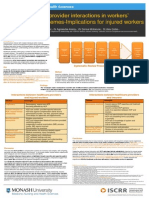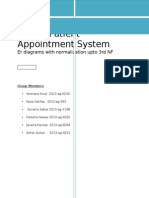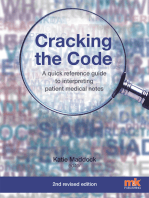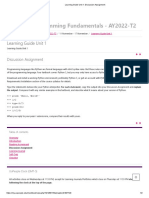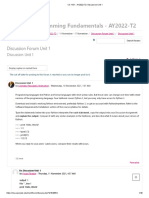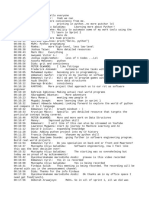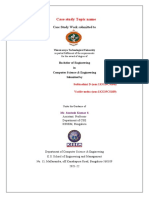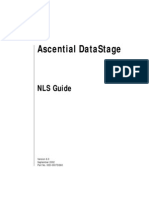Programming Assignment Unit 4
Programming Assignment Unit 4
Uploaded by
Lect urerCopyright:
Available Formats
Programming Assignment Unit 4
Programming Assignment Unit 4
Uploaded by
Lect urerCopyright
Available Formats
Share this document
Did you find this document useful?
Is this content inappropriate?
Copyright:
Available Formats
Programming Assignment Unit 4
Programming Assignment Unit 4
Uploaded by
Lect urerCopyright:
Available Formats
University of the People
CS 2203 – Database 1.
Dr. Vasha Himthani
Programming Assignment Unit 4.
The assignment must define or describe the changes required to get the relations into the 1st
normal form.
For a relation to be in the first normal form, it has to meet the following rules.
1. The relation must have domains that are indivisible (Sharma et al 2010)
2. Column to contain values of the same domain.
3. No duplicate rows.
4. Each column to have unique name.
5. No ordering of rows and column.
The doctor Relation in 1NF
Doctor Relation
Doctor ID Name Phone SpecialtyNumber Speciality Supervisor
Appointment Relation in 1NF
Appointment Relation.
AppointmentID DoctorID PatientD AppointmentDate BloodPressure Weight TreatmentNote
Medicine Relation
MedicineID medicines
Patient Relation in 1NF
Patient Relation.
PatientID Name Phone Email Address AddedDate DoctorID
Allergies Relation
AllergeyID Allergies
The assignment must define or describe the changes required to get the relations into the
2nd normal form.
For a relation to be in the 2NF, it must meet the following rules.
1. The relation must be in the 1NF
2. There should be no partial dependency in the relation.
The doctor Relation in 2NF
Doctor Relation
Doctor ID Name Phone SpecialtyNumber Specialty Supervisor
Specialty Relation
DoctorID SpecialtyNumber Specialty
The appointment relation and the patient relation as they are shown the 1NF above meet the
rules of 2NF.
The assignment should include an Entity Relationship diagram in 3rd normal form.
For the relation to be in 3NF, Sharma et al (2010) argues that it should meet following rules.
1. The relation must be in the 2NF
2. There is no non-key attribute that depends transitively on the candidate key.
3. Every attribute depends on primary key and it should not depend transitively on primary
key
Entity Relationship diagram that details the relationships between Relations.
In the diagram below, the primary key are the DOCTORID, PATIENTID, APPOINTMENTID,
ALLERGYID, MEDICINEID and SPECIALITY_NO
The description of the E-R diagram
The relationship between the specialty and doctor relation is one to one. Meaning one doctor
has one specialty.
The relationship between doctor to patient is one to many.
The relationship between allergy and patient is zero, one or many to one.
The relationship between patient and appointment is one to many.
The relationship between doctor and appointment is one to many.
And finally the relationship between medicine and appointment is zero, one or many to one.
Reference.
Sharma, N., Perniu, L., Chong, R. F., Iyer, A., Nandan, C., Mitea, A. C., Nonvinkere, M., &
Danubianu, M. (2010). Databases fundamentals. Download the pdf.
You might also like
- Klik-Sta-Ellinika Convert CompressDocument2 pagesKlik-Sta-Ellinika Convert CompressLect urer100% (1)
- HealthOne Medical DD ProjectDocument4 pagesHealthOne Medical DD ProjectIrfan Darmawan0% (1)
- CS 1101 - AY2022-T2 - Discussion Unit 4Document40 pagesCS 1101 - AY2022-T2 - Discussion Unit 4Lect urerNo ratings yet
- HealthOne Medical DD SolutionDocument11 pagesHealthOne Medical DD Solutionaldo SilvesterNo ratings yet
- Practical 5 Working With The BASH Shell and Shell ScriptsDocument6 pagesPractical 5 Working With The BASH Shell and Shell ScriptsWEI WEN NGNo ratings yet
- The Doctor PatientDocument17 pagesThe Doctor PatientMichael WillisNo ratings yet
- Centralization Versus Decentralization ADocument5 pagesCentralization Versus Decentralization AArjit AgarwalNo ratings yet
- STL11 2P - Doctors Interpersonal Skills - 114025Document23 pagesSTL11 2P - Doctors Interpersonal Skills - 114025pyong jNo ratings yet
- Doctor Nurse RelationshipDocument10 pagesDoctor Nurse RelationshipSherwan R Shal100% (1)
- Norcross Evidence-Based Therapy RelationshipsDocument33 pagesNorcross Evidence-Based Therapy Relationshipsttajmuch100% (1)
- Script For CebuDocument4 pagesScript For CebuDarlyn AmplayoNo ratings yet
- CPE5 AppendicesDocument55 pagesCPE5 Appendicescosmindudu1980No ratings yet
- The Enduring and Evolving Nature of The Patient-PhysicianDocument11 pagesThe Enduring and Evolving Nature of The Patient-PhysicianSYLVIA RAMIS ASENJONo ratings yet
- Far Eastern University Institute of Nursing: Clinical QuestionDocument6 pagesFar Eastern University Institute of Nursing: Clinical QuestionshielaniNo ratings yet
- 6 Kellymodule5Document7 pages6 Kellymodule5api-294260060No ratings yet
- DM - Report (1) (1) HARIDocument15 pagesDM - Report (1) (1) HARIprasen3110No ratings yet
- wk8 Final IlumxDocument8 pageswk8 Final Ilumxapi-316414872No ratings yet
- The Cost-Effectiveness of Family Therapy: A Summary and Progress Report D. Russell CraneDocument12 pagesThe Cost-Effectiveness of Family Therapy: A Summary and Progress Report D. Russell CraneAngel Paz-JesusNo ratings yet
- Research Proposal 1.1 Background of The StudyDocument9 pagesResearch Proposal 1.1 Background of The StudyFranklin GodshandNo ratings yet
- Professional BurnoutDocument5 pagesProfessional BurnoutCristina SavaNo ratings yet
- Foun 1001 WorkDocument4 pagesFoun 1001 WorkJosh FranklynNo ratings yet
- Letters: Annals of Internal MedicineDocument6 pagesLetters: Annals of Internal Medicinerobert93No ratings yet
- Trust in Leader and Self-Efficacy: The Impact On Organizational CommitmentDocument12 pagesTrust in Leader and Self-Efficacy: The Impact On Organizational CommitmentfairusNo ratings yet
- Project 2Document13 pagesProject 2api-526073737No ratings yet
- Ohtaki FamPract03Document7 pagesOhtaki FamPract03mahsa moosazadehNo ratings yet
- Effect of Patient Dissatisfaction With The Therapist On Group Therapy OutcomeDocument10 pagesEffect of Patient Dissatisfaction With The Therapist On Group Therapy OutcomeNegulescu A. AndreeaNo ratings yet
- Profesionalismo MedicoDocument15 pagesProfesionalismo MedicoR4pT0r666No ratings yet
- EBM On Harm - Dentistry 2010Document16 pagesEBM On Harm - Dentistry 2010Erfiadi Nur FahmiNo ratings yet
- Physicians' Perceptions of Communication With and Responsibilities of PharmacistsDocument7 pagesPhysicians' Perceptions of Communication With and Responsibilities of PharmacistsmutiaraNo ratings yet
- The Good TherapistDocument27 pagesThe Good TherapistHector LegrekNo ratings yet
- Nurse Physician Communication in Patient Care and Associated Factors in Public Hospitals of Harari Regional State and Dire-Dawa City Administration EDocument18 pagesNurse Physician Communication in Patient Care and Associated Factors in Public Hospitals of Harari Regional State and Dire-Dawa City Administration EFatima Zahra ElbadaouiNo ratings yet
- The Following Are The Factors That Could Influence The Relationship Between Doctor and PatientDocument2 pagesThe Following Are The Factors That Could Influence The Relationship Between Doctor and PatientBenjamin DanielNo ratings yet
- Occupational Burnout Levels in Emergency Medicine - A Nationwide Study and AnalysisDocument9 pagesOccupational Burnout Levels in Emergency Medicine - A Nationwide Study and Analysisshinichi kudoNo ratings yet
- NIH Public Access: Author ManuscriptDocument21 pagesNIH Public Access: Author ManuscriptranNo ratings yet
- 10 1016@j Socscimed 2019 112391Document8 pages10 1016@j Socscimed 2019 112391fatmadita17No ratings yet
- Article 5Document8 pagesArticle 5Purvesh PatelNo ratings yet
- Chapter 001Document4 pagesChapter 001Sajan VargheseNo ratings yet
- Multiple Regression AnalysisDocument3 pagesMultiple Regression AnalysisAlex MainaNo ratings yet
- Prabavathi.u Inter-Relation Between Clinical Name ChangedDocument63 pagesPrabavathi.u Inter-Relation Between Clinical Name ChangedVenkatram PrabhuNo ratings yet
- Correlational AnalysisDocument5 pagesCorrelational AnalysisOluwajuwon AdenugbaNo ratings yet
- Damodaram Sanjivayya National Law University, Nyayaprastha, Sabbavaram, Visakhapatnam, Andhra Pradesh-531035Document20 pagesDamodaram Sanjivayya National Law University, Nyayaprastha, Sabbavaram, Visakhapatnam, Andhra Pradesh-531035LegendNo ratings yet
- Therapist Personality Traits As PredictorsDocument15 pagesTherapist Personality Traits As PredictorsNL.10 Hernández Mendieta SaraNo ratings yet
- Therapist Personality Traits As Predictors of Psychological Treatment OutcomesDocument15 pagesTherapist Personality Traits As Predictors of Psychological Treatment OutcomesupasanaNo ratings yet
- Debriefing Edited EditedDocument4 pagesDebriefing Edited EditedMunyao JustusNo ratings yet
- Chicken Soup For The Unstable Shoulder - Stabilization Reduces Depressive SymptomsDocument2 pagesChicken Soup For The Unstable Shoulder - Stabilization Reduces Depressive Symptomsdemirhan demirkiranNo ratings yet
- Journal of Family Therapy - 2010 - Glebova - Therapeutic Alliance and Progress in Couple Therapy Multiple PerspectivesDocument24 pagesJournal of Family Therapy - 2010 - Glebova - Therapeutic Alliance and Progress in Couple Therapy Multiple PerspectivesMatias RiosNo ratings yet
- Alianza Terapeutica en TPDocument10 pagesAlianza Terapeutica en TPkatherineNo ratings yet
- Assault On DoctorsDocument3 pagesAssault On DoctorsvyshnosudhaNo ratings yet
- Factor Analyses of Psychoanalytic, Non-Directive, and Adlerian Therapeutic RelationshipsDocument7 pagesFactor Analyses of Psychoanalytic, Non-Directive, and Adlerian Therapeutic RelationshipsTales Fernandes100% (1)
- User Guide PDFDocument3 pagesUser Guide PDFAzizatul HamidiyahNo ratings yet
- Nursing Errors - Case Study AttachedDocument4 pagesNursing Errors - Case Study AttachedNDINDA GODYFREEY NATTOHNo ratings yet
- Healthcare Provider Interactions in Workers Compensation Schemes-Implications For Injured Workers Beth Kilgour ACHRF 2013Document1 pageHealthcare Provider Interactions in Workers Compensation Schemes-Implications For Injured Workers Beth Kilgour ACHRF 2013ISCRRNo ratings yet
- Entity-Relationship Diagrams (ERD)Document5 pagesEntity-Relationship Diagrams (ERD)Jelyn SustiguerNo ratings yet
- Patient-Physician RelationshipDocument11 pagesPatient-Physician RelationshipNataliya PiletskaNo ratings yet
- Communication and Doctor Patient Relationship PDFDocument3 pagesCommunication and Doctor Patient Relationship PDFQuraisha DawoodNo ratings yet
- Beck - Physician - Patient Communication - 2002Document14 pagesBeck - Physician - Patient Communication - 2002Judit Cs. GaramiNo ratings yet
- Dispensing LabDocument3 pagesDispensing Labtawasilzai21No ratings yet
- Dental Patient Appointment SystemDocument19 pagesDental Patient Appointment SystemSahar Sultan67% (3)
- Week 3 Health Communication - RuttenDocument4 pagesWeek 3 Health Communication - RuttencoffeedanceNo ratings yet
- CSCC43: Tutorial #6: ER ProblemDocument2 pagesCSCC43: Tutorial #6: ER ProblemAziz.3251No ratings yet
- Running Head: Role Strain and Burnout in Nursing 1Document6 pagesRunning Head: Role Strain and Burnout in Nursing 1edwin GikundaNo ratings yet
- Cracking the Code: A quick reference guide to interpreting patient medical notesFrom EverandCracking the Code: A quick reference guide to interpreting patient medical notesNo ratings yet
- Perfect Phrases for Healthcare Professionals: Hundreds of Ready-to-Use PhrasesFrom EverandPerfect Phrases for Healthcare Professionals: Hundreds of Ready-to-Use PhrasesNo ratings yet
- CS 1101 - AY2022-T2 - Discussion Unit 2Document48 pagesCS 1101 - AY2022-T2 - Discussion Unit 2Lect urerNo ratings yet
- CS 1101 - AY2022-T2 - Discussion Unit 8Document29 pagesCS 1101 - AY2022-T2 - Discussion Unit 8Lect urerNo ratings yet
- CS 1101 - AY2022-T2 - Discussion Unit 5Document40 pagesCS 1101 - AY2022-T2 - Discussion Unit 5Lect urerNo ratings yet
- Learning Guide Unit 1 - Discussion AssignmentDocument2 pagesLearning Guide Unit 1 - Discussion AssignmentLect urerNo ratings yet
- Course: Psyc 2504/written Assignment/Unit 4: Instructor: Dr. Mary Martin DATE: 23Document5 pagesCourse: Psyc 2504/written Assignment/Unit 4: Instructor: Dr. Mary Martin DATE: 23Lect urerNo ratings yet
- CS 1101 - AY2022-T2 - Discussion Unit 1Document40 pagesCS 1101 - AY2022-T2 - Discussion Unit 1Lect urerNo ratings yet
- Disscussion Post Unit 1Document1 pageDisscussion Post Unit 1Lect urerNo ratings yet
- PSYC 1504 Written Assignment Unit 4Document4 pagesPSYC 1504 Written Assignment Unit 4Lect urerNo ratings yet
- GMT20220919-120334 RecordingDocument6 pagesGMT20220919-120334 RecordingLect urerNo ratings yet
- Practice 4 PDFDocument5 pagesPractice 4 PDFuserNo ratings yet
- CryptoworkDocument7 pagesCryptoworkAnonymous 23No ratings yet
- CS401 - Short Notes Chapter 9Document3 pagesCS401 - Short Notes Chapter 9Zoha SheikhNo ratings yet
- Operating Juniper Networks Routers in The Enterprise: Chapter 3: JUNOS User InterfacesDocument66 pagesOperating Juniper Networks Routers in The Enterprise: Chapter 3: JUNOS User InterfacesJackzidNo ratings yet
- RFID Projek - Student Attendance Class Using MySQL Database - Projek ElektronikDocument4 pagesRFID Projek - Student Attendance Class Using MySQL Database - Projek ElektronikAdhyy AdhyyNo ratings yet
- Converting and Exporting Data in XML Format - BroadcastingDocument10 pagesConverting and Exporting Data in XML Format - BroadcastingCátia Coelho SilvaNo ratings yet
- Configuring HP-UX Containers (SRP) v3.01 UpdateDocument96 pagesConfiguring HP-UX Containers (SRP) v3.01 UpdateRogerio Gonçalves100% (1)
- Chapter 2 Solutions: Review QuestionsDocument4 pagesChapter 2 Solutions: Review QuestionsOrpheo NgadimanNo ratings yet
- TLE-TE 9 - Q1 - W5 - Mod5 - ICT CSSDocument31 pagesTLE-TE 9 - Q1 - W5 - Mod5 - ICT CSSrose arianne nadayao100% (4)
- Lab#06 HashingDocument4 pagesLab#06 HashingUzair KhanNo ratings yet
- Scaling Oracle8i.jamesMorleDocument529 pagesScaling Oracle8i.jamesMorlemyronNo ratings yet
- Label Printing Using Smart FormsDocument9 pagesLabel Printing Using Smart FormsEmil SNo ratings yet
- IDRAC8 User's GuideDocument335 pagesIDRAC8 User's GuideMilton RaimundoNo ratings yet
- Data Report: Device InformationDocument11 pagesData Report: Device InformationRoberto De Godos CarreraNo ratings yet
- Which T-Code Is Used Give Brief Description of All T-CodesDocument37 pagesWhich T-Code Is Used Give Brief Description of All T-CodesmkumarshahiNo ratings yet
- Schweitzer SEL Events Master ProtocolDocument20 pagesSchweitzer SEL Events Master ProtocolJOSENo ratings yet
- Compact DiscDocument15 pagesCompact Disca2962109No ratings yet
- Tcpdump ManualDocument91 pagesTcpdump ManualejjhkbNo ratings yet
- File System Case StudyDocument23 pagesFile System Case StudyV snehaNo ratings yet
- 25S CS107 Midterm SolutionDocument7 pages25S CS107 Midterm SolutionKhatia IvanovaNo ratings yet
- Telnet Commands: Connect To Online HelpDocument2 pagesTelnet Commands: Connect To Online HelpJitendra SinghNo ratings yet
- Ascential Datastage: Nls GuideDocument138 pagesAscential Datastage: Nls GuideVani GarikipatiNo ratings yet
- Cisco Packet TracerDocument15 pagesCisco Packet Tracerrqi11No ratings yet
- Ascii Character Set and AnsiDocument5 pagesAscii Character Set and AnsijmuzikNo ratings yet
- Funda 2 Log - Archive 1 - 10th MayDocument9 pagesFunda 2 Log - Archive 1 - 10th Mayapi-3745527No ratings yet
- Date Conversions in - Free Form RPGLE (117 Total) TABLE LIST - Updated 2015 11 30 - PDFDocument21 pagesDate Conversions in - Free Form RPGLE (117 Total) TABLE LIST - Updated 2015 11 30 - PDFRICARDO JAVIER ORTEGA ESPINOSANo ratings yet
- Universal Driver 4.5 UpgradeDocument28 pagesUniversal Driver 4.5 Upgrademlazar2000No ratings yet
- Bachelor of Computer Application (BCA) - Semester 5 BC0056 - Unix Operating SystemDocument3 pagesBachelor of Computer Application (BCA) - Semester 5 BC0056 - Unix Operating SystemparasramaNo ratings yet
- Mining Frequent Patterns, Associations and Correlations: Basic Concepts and MethodsDocument20 pagesMining Frequent Patterns, Associations and Correlations: Basic Concepts and MethodsLakshmi Priya BNo ratings yet







